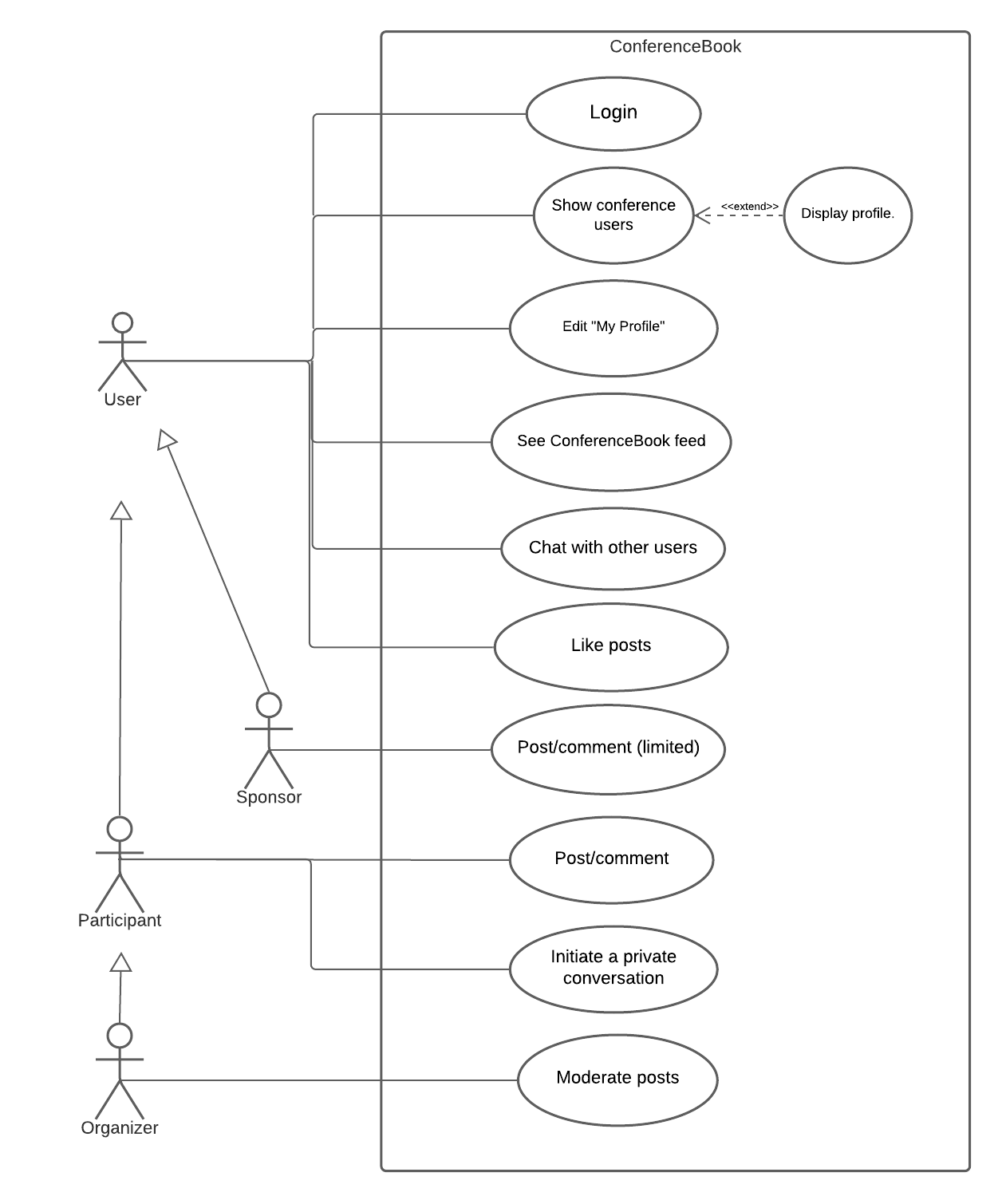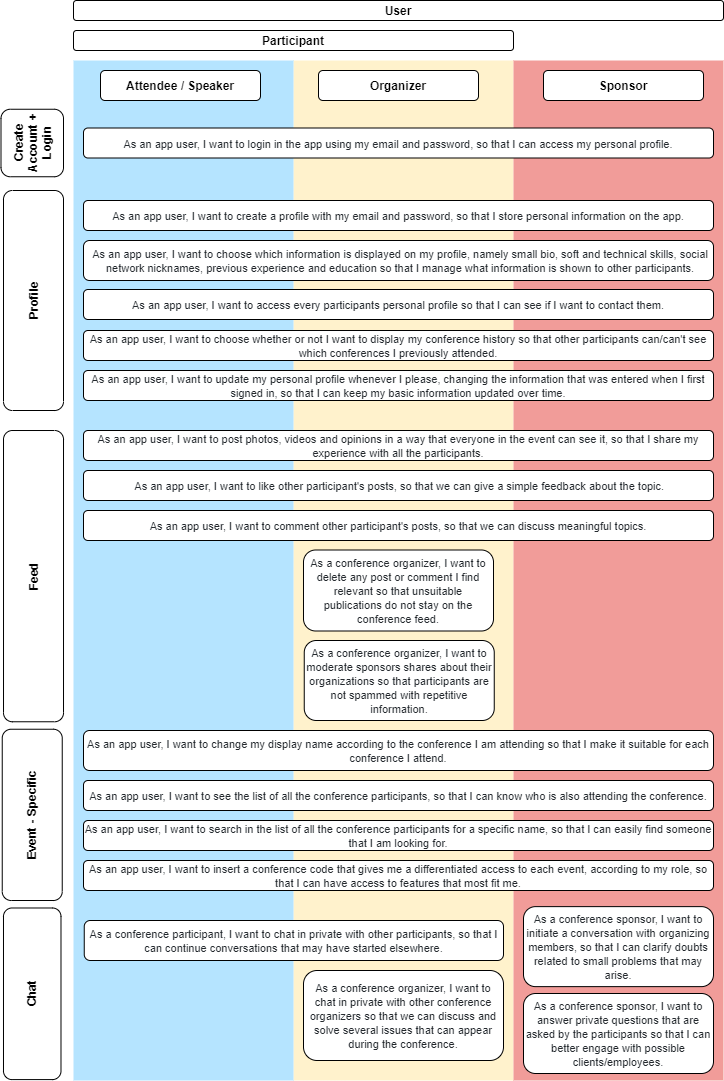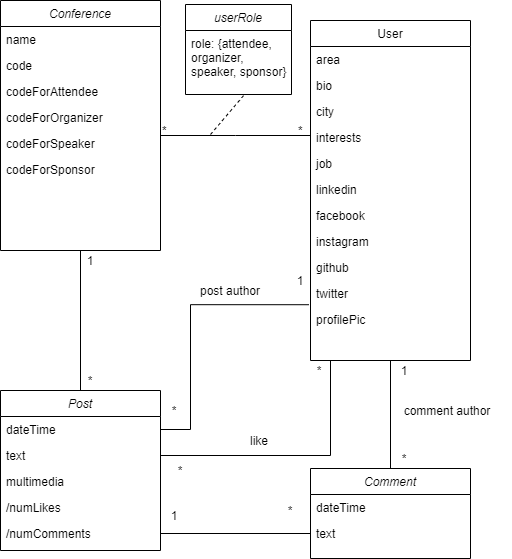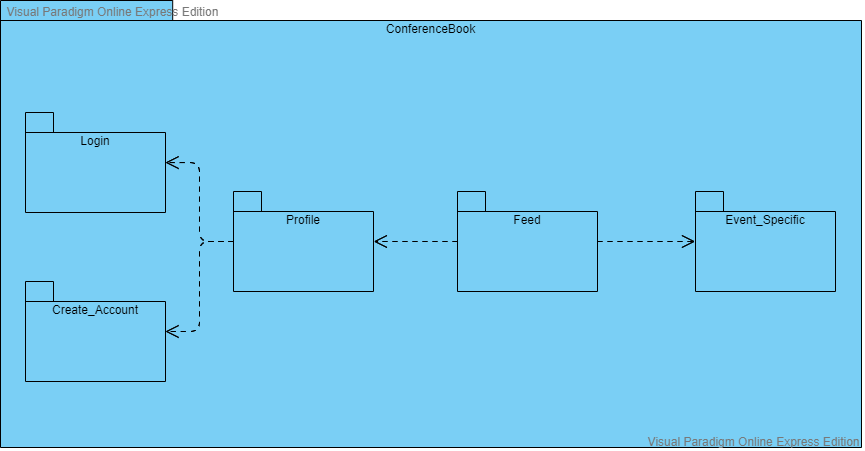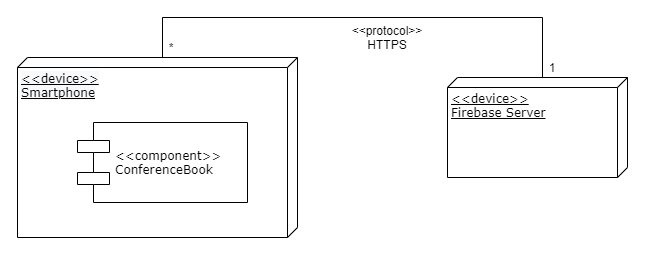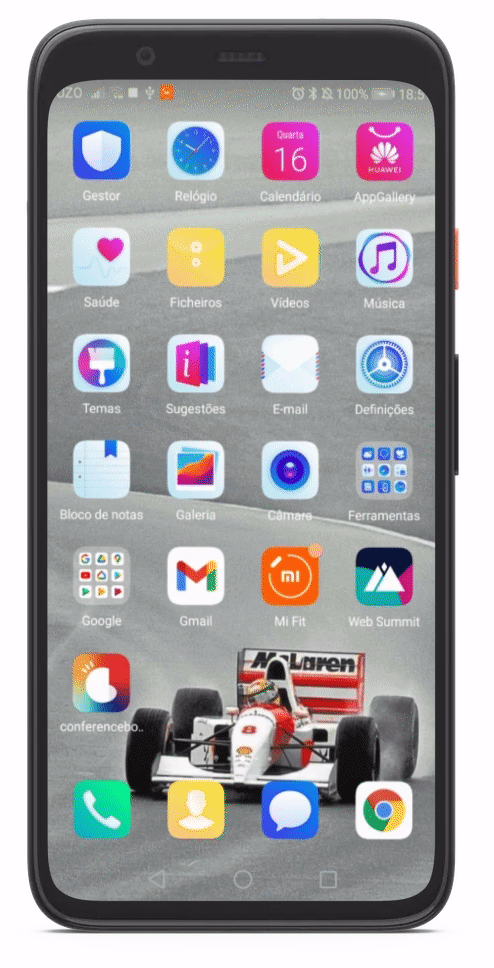Welcome to the documentation pages of the ConferenceBook of openCX!
You can find here detailed about the ConferenceBook, hereby mentioned as module, from a high-level vision to low-level implementation decisions, a kind of Software Development Report , organized by discipline (as of RUP):
- Business modeling
- Requirements
- Architecture and Design
- Implementation
- Test
- Configuration and change management
- Project management
So far, contributions are exclusively made by the initial team, but we hope to open them to the community, in all areas and topics: requirements, technologies, development, experimentation, testing, etc.
Please contact us!
Thank you!
- Guilherme Lucas Peralta
- João Carlos Machado Rocha Pires
- João Carlos Ramos Gonçalves de Matos
- Maria Jorge Miranda Loureiro
Grade of this Project: 20/20
There is always a time in physical or virtual conferences when you wish you could share a thought, experience, or chat with another participant. ConferenceBook is a social network to enhance this communication. Connecting people, towards mind broadening and empowerment of relationships.
Most conferences fail when it comes to communication amongst participants. That's the reason why we created ConferenceBook: an app to make this communication easier than ever, providing participants with a full networking experience. ConferenceBook allows attendees, speakers, organizers and sponsors to interact with each others, by making posts, sharing contacts and interests, and chatting, in a personalized way for each need or taste. Joining ConferenceBook means tapping into a place where all your favourite events are, with tools for knowledge sharing which is exclusive for each event's environment. With ConferenceBook, your event will become more appealing to your participants!
- Actor: User
- Description: This use case exists so that a user can login into ConferenceBook.
- Preconditions and Postconditions: In order to sucessfully login, the user must have created an account and use a valid email/password pair. In the end, the user will be able to acess the event's feed.
- Normal Flow: i) User types email/password ii) System validates email/password pair iii) System will show the event's feed
- Alternative Flows and Exceptions:
i) User types email/password
ii) System validates email/password pair and emmits error message
- OR i) User types email/password ii) System validates email/password pair iii) If it is the first time the user accesses ConferenceBook, the system will redirect user to a page where the user should insert the event's code
- Actor: User
- Description: This use case exists so that a user can see every other user on the event and, if he wishes, display another user's profile.
- Preconditions and Postconditions: In order to access the user's list, the user must be logged in and have access to the event in question. In the end, a user's list will be displayed.
- Normal Flow: i) User's list is displayed
- Alternative Flows and Exceptions: i) User's list is displayed ii) User clicks another user's profile iii) The clicked profile is displayed
- Actor: User
- Description: This use case exists so that a user can add or update information in his profile.
- Preconditions and Postconditions: In order to edit his profile, the user must be logged in and add new information in his profile. In the end, the user's profile will be updated.
- Normal Flow: i) User's current profile is displayed ii) User adds/updates information on his profile iii) User validates the changes iv) System saves the new information
- Alternative Flows and Exceptions: i) User's current profile is displayed ii) User adds/updates information on his profile iii) User doesn't validate the changes iv) System keeps the old information
- Actor: User
- Description: This use case exists so that a user can see, by inverse order of posting, all the posts in the ConferenceBook feed, using the infinite scroll technique.
- Preconditions and Postconditions: In order to see the feed, the user must be logged in, have access to the event in question and scroll through out the posts. In the end, the user will have catched up on as many posts as he wishes.
- Normal Flow: i) System shows event's feed ii) User scrolls down to see past publications iii) The system will keep showing older publications as long as the user keeps scrolling and there are more publications to be shown
- Alternative Flows and Exceptions: i) System shows event's feed ii) User scrolls up to refresh to newer publications iii) The system will show the new posts which have been made between the moment the user got to the feed page and the moment he refreshed the feed
- Actor: User
- Description: This use case exists so that a user can respond a conversation initiated by a Participant. This means that a Sponsor cannot be the one initiating a conversation, but he can keep it going.
- Preconditions and Postconditions: In order to chat with other users, the user must be logged in, have access to the event in question and respond to the other user's message. In the end, a dialogue between two users will have been made and the conversation record will stay on the chat.
- Normal Flow: i) System pops a message through chat ii) User reads and responds the message iii) User hits 'Send' iv) System sends the message
- Alternative Flows and Exceptions:
i) System pops a message through chat
ii) User reads and responds the message
iii) User doesn't hit 'Send'
iv) System doesn't send the message
- OR i) System pops a message through chat ii) User reads the message
- Actor: User
- Description: This use case exists so that a user can like a post made by another user.
- Preconditions and Postconditions: In order to like posts, the user must be logged in and have access to the event in question. In the end, a like from the user will appear on the post
- Normal Flow: i) User clicks like button ii) System adds like to the publication
- Alternative Flows and Exceptions: i) User unclicks like button ii) System removes like from the publication
- Actor: Sponsor
- Description: This use case exists so that a sponsor can post/comment on the ConferenceBook feed while, at the same time, preventing him from overloading the feed with publicity. As is, the sponsor will have a limited amount of posts/comments he can make (unless the sponsor is responding to comments on his own post)
- Preconditions and Postconditions: In order to post/comment posts on an event, the sponsor must be logged in and have his sponsorship validated. In the end, posts and comments made by the sponsor will appear on the feed.
- Normal Flow: i) System shows a place to post/comment ii) Sponsor posts/comments something iii) Sponsor hits 'post'/'comment' iv) System posts/comments a publication
- Alternative Flows and Exceptions:
i) System shows a place to post/comment
ii) Sponsor posts/comments something
iii) Sponsor doesn't hits 'post'/'comment'
iv) System doesn't posts/comments a publication
- OR i) System shows a place to post/comment ii) Sponsor posts/comments/ something iii) Sponsor hits 'post'/'comment', but the maximum of posts/comments has been achieved iv) System displays error message
- Actor: Participant
- Description: This use case exists so that a participant can post/comment photographs, videos and/or text on the ConferenceBook feed
- Preconditions and Postconditions: In order to post and comment posts on an event, the participant must be logged in and have access to the event in question. In the end, posts and comments made by the participant will appear on the feed.
- Normal Flow: i) System shows a place to post/comment ii) Participant posts/comments something iii) Participant hits 'post'/'comment' iv) System posts/comments a publication
- Alternative Flows and Exceptions: i) System shows a place to post/comment ii) Participant posts/comments something iii) Participant doesn't hits 'post'/'comment' iv) System doesn't posts/comments a publication
- Actor: Participant
- Description: This use case exists so that a participant can initiate a private conversation with another user on the ConferenceBook's chat.
- Preconditions and Postconditions: In order to initiate a private conversation, the participant must be logged in and have access to the event in question. In the end, the participant will have started a conversation with another user
- Normal Flow: i) Participant opens chat with another user ii) Participant types a message iii) Participant hits 'send' iv) System sends the message
- Alternative Flows and Exceptions: i) Participant opens chat with another user ii) Participant types a message iii) Participant doesn't hit 'send' iv) System doesn't send the message
- Actor: Organizer
- Description: This use case exists so that an organizer can moderate the posts (delete or manage spam posts) on the ConferenceBook feed.
- Preconditions and Postconditions: In order to moderate the post, the organizer must be logged in. In the end, there won't be hatred nor spam posts on the ConferenceBook feed.
- Normal Flow: i) Moderator finds a hatred post ii) Moderador clicks delete button iii) System deletes the post iv) System notifies user of the deletion of his post
- Alternative Flows and Exceptions: i) Moderator finds a spam post ii) Moderador warns sponsor
In the following sections, roles for every user story are described and an user story map is presented, allowing a more global view of all the user stories of this project.
User story and their mockups are present in the comments of each issue in GitHub Projects, as well as the acceptance tests for each one of them.
The link for our board can be found here.
General role, includes every user of the conference, be it attendee, speaker, organizer or sponsor.
This role includes attendees, speakers and organizers of the conference, since they will have the same funcionalities while using the app. In addition, organizers will have an extent of this role, since they will have additional funciontalities, explained bellow.
This roll will be assigned to the organizers of each conference. Naturally, they will play an important role in moderating the feed and helping participants with anything they need.
This roll will belong to representatives of organizations or institutions that will be present at the event. In this sense, they will have different objectives from the attendees and, therefore, different actions.
Conferencebook is built on top of the well-known concept of social network. However, unlike most social networks, it is restricted to the ones present in a conference, which must be registered in Conferencebook.
-
Each conference has an id, name, and code. Each conference participant is given, a priori, a specific code for the conference and role to be taken, which can be of Attendee, Speaker, Sponsor, or Organizer. Therefore, each conference has a set of codes, for registration: codeForAttendee, codeForSpeaker, codeForSponsor, and codeForOrganizer.
-
A user can create an account in Conferencebook as usually done in similar platforms, with email and password, and can construct his profile with information of interest to other participants, such as: area of work, short biography, city of living, interests, and job. For an enhanced connectivity with existing platforms for communication and knowledge sharing, users can add to their profile the nicknames for: LinkedIn, Facebook, Instagram, GitHub, and Twitter. A profile picture can also be included. A user is associated to each conference with the role played, thus enabling the possibility of playing different roles in different conferences. Conferences can have as many users as wished, and users can join as many conferences as wished, too.
-
An unlimited number of posts can be done, associated to each conference. Each post has a date and time, stating when it was created; the user who creates the post is also saved. The post itself can contain text and/or multimedia: a photo or a video. Similarly to what happens in any social network, the app users can leave a like or a comment. Therefore, each post has a number of Likes and Comments saved. Each post is associated to a single conference.
-
Associated to each post, and unlimited number of comments can exist. Similarly to what happens for posts, each comment can be created by a single user, responding to a single post, and has a date and time, a number of Likes, and a text, containg the message.
The best approach towards the simplification of the project structure is the MVC approach.
The Event_Specific package includes items for event management and moderation.
The Profile package contains the files regarding the profile information management and as such depends on the Login and the Create_Account packages, which are, respectively, responsible for the files relating the login and the account creation actions.
The Feed Package includes items related with the display and storing of the home feed information. It depends on both the Event-Specific and the Profile packages, as information regarding the profile and relative to event characteristics (for example, the event moderation settings) are crucial for the home feed publications.
Our project's physical structure is very simple. The user installs ConferenceBook on their smartphone, and whenever the need to connect with our database arises, it communicates with it via HTTPS requests, where it will store and retrieve all the information needed.
With this in mind, we wrote a general Deployment Diagram, with the two devices that compose our system.
Our project was fully developed using Flutter - an emerging framework for mobile development that supports both iOS and Android - combined with Firebase to store participants and conferences data. We used Firebase for our database server because of its easy integration with flutter, as well as simple setup.
The features to be tested are the following ones:
The reason why we decided to test these features is because we consider them to be among the most important ones in our application:
- Login is the starting point of the app and the responsible one for the authentication of an user
- Insert an event code represents the only way to access all functionalities of the app.
- Making a post represents one possible interaction with the app, and possible the most important one.
The implementation of the acceptance tests for these features was done with Gherkin, with the aid of flutter_gherkin package for Flutter.
The automation of these tests is the following:
Feature: Login
User should be able to login using an email and password.
Scenario: User do a successful login with an email and password
- Given I'm in the "Login" screen
- When I fill the "emailfield" field with "teste@gherkin.com"
- And I fill the "passwordfield" field with "123456"
- And I tap the "loginbutton" button
- Then I see the "JoinAnEvent" screen
Feature: New Event
User should be able to enter in a new event by inserting a valid code.
Scenario: Enter in a new event
- Given I'm the user test@gherkin.com, I'm logged in and I see the "JoinAnEvent" screen
- When I tap the "neweventcode" button
- Then I see the "EnterEventCode" screen
- When I fill the "eventcodefield" field with "WS2020Attendee"
- And I tap the "entereventcode" button
- Then I see the "HomeFeed" screen
Feature: Post
User should be able to make a new post from the HomeFeed of some event.
Scenario: Make a post
- Given I'm the user test@gherkin.com, I'm logged in, I'm as a participant at WebSummit2020 and I see the "HomeFeed" screen
- When I tap the "addpost" button
- Then I see the "NewPost" screen
- When I fill the "textfield" field with "This is a test post"
- And I tap the "Post" button
- Then I see the "HomeFeed" screen
Note: The test above only succeed if the organizers of the conference used for the test didn't block new posts.
The results of the tests were the following:
The demo of the tests is the following:
Note: The above GIF is the composition of all the tests, which were runned independently.
The tool used for Project Management was GitHub Projects. The link for our board can be found here.
